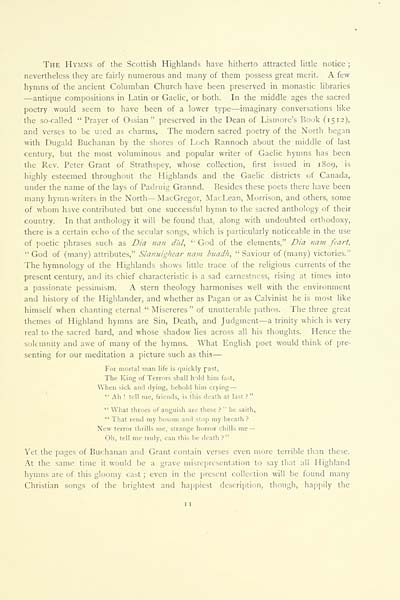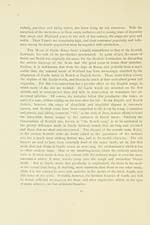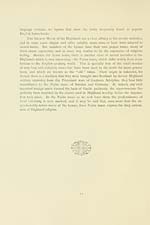Download files
Complete book:
Individual page:
Thumbnail gallery: Grid view | List view

The Hymns of the Scottish Highlands have hitherto attracted little notice ;
nevertheless they are fairly numerous and many of them possess great merit. A few
hymns of the ancient Columban Church have been preserved in monastic libraries
— antique compositions in Latin or Gaelic, or both. In the middle ages the sacred
poetry would seem to have been of a lower type — imaginary conversations like
the so-called " Prayer of Ossian " preserved in the Dean of Lismore's Book (1512),
and verses to be used as charms. The modern sacred poetry of the North began
with Dugald Buchanan by the shores of Loch Rannoch about the middle of last
century, but the most voluminous and popular writer of Gaelic hymns has been
the Rev. Peter Grant of Strathspey, whose collection, first issued in 1809, is
highly esteemed throughout the Highlands and the Gaelic districts of Canada,
under the name of the lays of Padruig Grannd. Besides these poets there have been
many hymn-writers in the North — MacGregor, MacLean, Morrison, and others, some
of whom have contributed but one successful hymn to the sacred anthology of their
country. In that anthology it will be found that, along with undoubted orthodoxy,
there is a certain echo of the secular songs, which is particularly noticeable in the use
of poetic phrases such as Dia nan did, " God of the elements," Dia nam fiart,
" God of (many) attributes," Slanuighear nam buadh, " Saviour of (many) victories."
The hyranology of the Highlands shows little trace of the religious currents of the
present century, and its chief characteristic is a sad earnestness, rising at times into
a passionate pessimism. A stern theology harmonises well with the environment
and history of the Highlander, and whether as Pagan or as Calvinist he is most like
himself when chanting eternal " Misereres " of unutterable pathos. The three great
themes of Highland hymns are Sin, Death, and Judgment — a trinity which is very
real to the sacred bard, and whose shadow lies across all his thoughts. Hence the
solemnity and awe of many of the hymns. What English poet would think of pre-
senting for our meditation a picture such as this — •
For mortal man life is quickly fast,
The King of Terrors shall hold him fast.
When sick and dying, behold him crying —
" Ah ! tell me, friends, is this death at last ? "
" What throes of anguish are these ? " he saith,
" That rend my bosom and stop my breath ?
New terror thrills me, strange horror chills me —
Oh, tell mc truly, cm this he death ?"
Vet the Images of Buchanan and Grant roulain verses even more terrible than tliese.
At the same titne it wotild lie a grave misrepresentation to say that all Highland
hytiins are of this glootiiy cast ; even in the [iresent collection will be found many
Christian songs of the brightest and happiest description, though, happily the
nevertheless they are fairly numerous and many of them possess great merit. A few
hymns of the ancient Columban Church have been preserved in monastic libraries
— antique compositions in Latin or Gaelic, or both. In the middle ages the sacred
poetry would seem to have been of a lower type — imaginary conversations like
the so-called " Prayer of Ossian " preserved in the Dean of Lismore's Book (1512),
and verses to be used as charms. The modern sacred poetry of the North began
with Dugald Buchanan by the shores of Loch Rannoch about the middle of last
century, but the most voluminous and popular writer of Gaelic hymns has been
the Rev. Peter Grant of Strathspey, whose collection, first issued in 1809, is
highly esteemed throughout the Highlands and the Gaelic districts of Canada,
under the name of the lays of Padruig Grannd. Besides these poets there have been
many hymn-writers in the North — MacGregor, MacLean, Morrison, and others, some
of whom have contributed but one successful hymn to the sacred anthology of their
country. In that anthology it will be found that, along with undoubted orthodoxy,
there is a certain echo of the secular songs, which is particularly noticeable in the use
of poetic phrases such as Dia nan did, " God of the elements," Dia nam fiart,
" God of (many) attributes," Slanuighear nam buadh, " Saviour of (many) victories."
The hyranology of the Highlands shows little trace of the religious currents of the
present century, and its chief characteristic is a sad earnestness, rising at times into
a passionate pessimism. A stern theology harmonises well with the environment
and history of the Highlander, and whether as Pagan or as Calvinist he is most like
himself when chanting eternal " Misereres " of unutterable pathos. The three great
themes of Highland hymns are Sin, Death, and Judgment — a trinity which is very
real to the sacred bard, and whose shadow lies across all his thoughts. Hence the
solemnity and awe of many of the hymns. What English poet would think of pre-
senting for our meditation a picture such as this — •
For mortal man life is quickly fast,
The King of Terrors shall hold him fast.
When sick and dying, behold him crying —
" Ah ! tell me, friends, is this death at last ? "
" What throes of anguish are these ? " he saith,
" That rend my bosom and stop my breath ?
New terror thrills me, strange horror chills me —
Oh, tell mc truly, cm this he death ?"
Vet the Images of Buchanan and Grant roulain verses even more terrible than tliese.
At the same titne it wotild lie a grave misrepresentation to say that all Highland
hytiins are of this glootiiy cast ; even in the [iresent collection will be found many
Christian songs of the brightest and happiest description, though, happily the
Set display mode to: Large image | Transcription
Images and transcriptions on this page, including medium image downloads, may be used under the Creative Commons Attribution 4.0 International Licence unless otherwise stated. ![]()
| Early Gaelic Book Collections > Blair Collection > Songs and hymns of the Scottish Highlands > (15) |
|---|
| Permanent URL | https://digital.nls.uk/75799563 |
|---|
| Description | A selection of books from a collection of more than 500 titles, mostly on religious and literary topics. Also includes some material dealing with other Celtic languages and societies. Collection created towards the end of the 19th century by Lady Evelyn Stewart Murray. |
|---|
| Description | Selected items from five 'Special and Named Printed Collections'. Includes books in Gaelic and other Celtic languages, works about the Gaels, their languages, literature, culture and history. |
|---|

